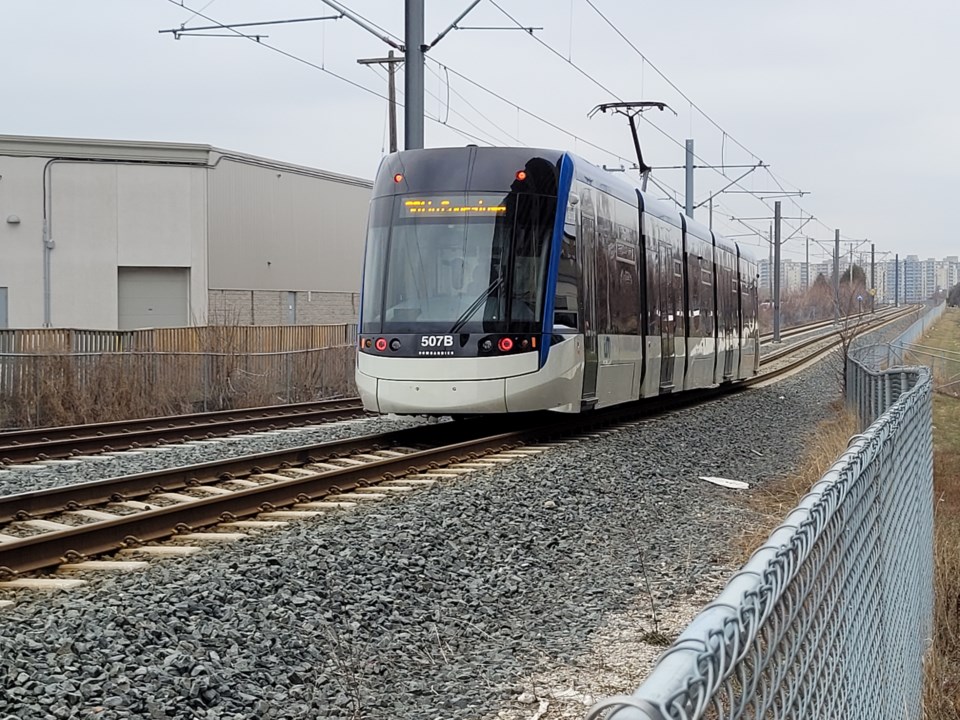The estimated all-in capital cost to extend the ION’s route into downtown Cambridge sometime within the next 11 years is $4.5 billion.
The latest numbers, which were provided in an update to the region’s planning and works committee Tuesday, include all the soft and hard costs to build, plan and design the route, acquire properties and purchase vehicles.
Matthew O’Neil, manager of rapid transit coordination with the region, provided the update as work continues on the business case for the project; work that is integral to securing funding from upper levels of government once all design work is completed.
In order to provide options in the massive funding request, the region has added a route evaluation as part of its costing exercise that includes shorter routes.
O’Neil said staff explored shortened lengths for the ION route, including one that ends at Pinebush and Hespeler Road and one that ends at the Delta intersection, because the Ministry of Transportation will expect it as part of the business case.
The preferred route for the Stage 2 ION, endorsed by council in 2019, is 17.5 kilometres between Fairway and the southern terminus near the Ainslie Street bus terminal in downtown Cambridge.
The cost of acquiring properties alone varies from $125 million to $200 million and would have to be borne solely by the region.
The annualized operation, maintenance and rehabilitation costs for the 30-year lifespan of the ION along the Stage 2 route would be between $9.4 million and $22.6 million depending on its length.
“I guess the big question here is the $4.463 billion,” said Coun. Pam Wolf. “That’s a lot of money. Do we think the federal and provincial governments are going to fund this?”
O’Neil admitted it’s a difficult question to answer.
“The factors really would come down to, in all likelihood, the strength of the business case," he said. "There have been projects that have received full funding and there are projects that have not received full capital funding.”
Wolf then asked if, in the meantime, “while we’re waiting for this magical funding” and in an effort to increase transit ridership, if it would be possible to bring a rapid bus project to Cambridge, along the proposed LRT corridor.
“In Cambridge, we really need to improve our transportation system,” she said, adding the city’s residents have been paying for the LRT since its inception and will continue to pay.
O’Neil said it’s another complicated question he couldn’t answer without knowing how it would align with the goals the region has for the LRT project. Those include everything from promoting intensification in city cores to reducing urban sprawl and providing connectivity to the planned transit hub.
He’s also unsure if the route would be suitable for buses in the same way it makes sense for the LRT.
“We would need to run a business case to test that,” he said.
Coun. Chantal Huinink noticed that the shortest route, ending at the Pinebush station, isn’t half the cost and asked if financial considerations alone are behind the alternatives.
“I’m kind of of the mindset that if we’re going to go into this, we should go all the way, literally and figuratively,” she said.
Coun. Doug Craig added his concerns about the costing.
“We need to have some sort of commentary from someone that will look at this and say to us if this is realistic because quite frankly I don’t believe it is, in any sense of the word,” he said. “No government is going to give $4.46 billion to Cambridge around an LRT.”
Craig said he agrees with rapid transit, agrees Cambridge needs something, but feels the region needs to consider another perspective, mainly looking at the reality of what's feasible.
He suggested a peer review of the situation before more work is put into it.
Coun. Rob Deutschman agreed questions need to be answered, but wants the project to advance.
Council voted to defer adopting the alternative route options until a later date.
Last year, the region hired a consultant to re-evaluate its south terminus in downtown Galt and expects to see that work complete by this summer.
Starting in the fall, the region will be able to issue a request for proposals for an initial business case and complete a functional design for the south terminus.
The region expects to have its initial business case for Stage 2 completed next year, followed by field investigations and preliminary design work in 2025 and 2026.
O’Neil said that work is necessary to advance the project to “a higher class of cost estimate,” reduce risks and be in a position where the region has cost estimates that meet the standard for funding requests to the province and feds.
Right now, “it’s not quite at a level where the treasury board is going to take that number and we could expect a commitment,” he said.
The preliminary design business case for the project would come in 2027 as funding applications begin to roll out.




